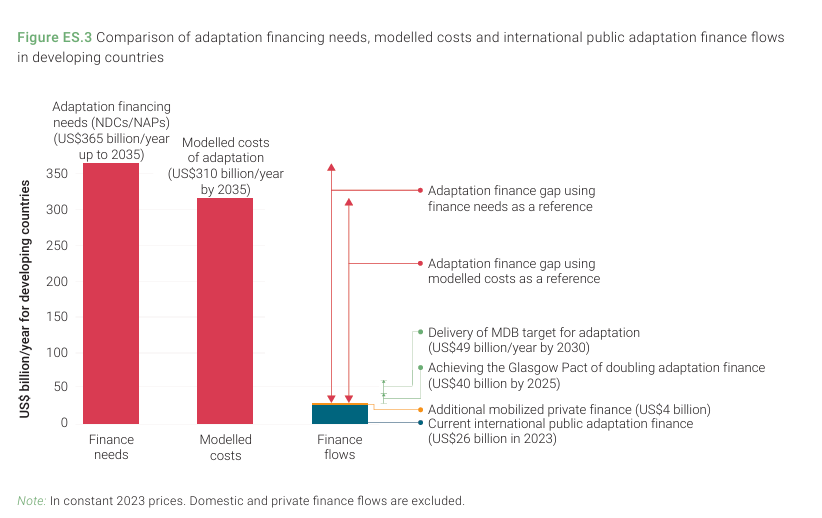Syllabus:
GS-3: Conservation, environmental pollution and degradation, environmental impact assessment
Context: “The Adaptation Gap Report 2025: Running on Empty (AGR)” was released on a day when the Caribbean Island of Jamaica lies devastated by the impact of Hurricane Melissa.
Key Highlights of the report
• Rising Adaptation Costs:
- Developing countries will need between USD 310 billion to 365 billion annually by 2035 to cope with ongoing and future climate impacts.
- Inflation adjustments could raise the cost to between USD 440 billion to 520 billion annually.
• Funding Shortfall: International public adaptation finance fell to USD 26 billion in 2023, down from USD 28 billion the previous year, creating an adaptation finance gap estimated between USD 284 billion to 339 billion annually.
• Slow Progress on Climate Finance Goals:
- The report warns that the Glasgow Climate Pact goal to double adaptation finance by 2025 to USD 40 billion is unlikely to be met under current trends.
- The New Collective Quantified Goal agreed at COP29 aims for USD 300 billion annually for climate action by 2035 but remains insufficient to close the adaptation gap.
• Increasing Adaptation Planning: About 172 out of 197 countries now have at least one national adaptation policy, plan, or strategy.

• Limited Private Sector Participation: The private sector contribution to adaptation finance currently stands at USD 5 billion and may rise to USD 50 billion annually with targeted policy action and blended finance approaches, but this is inadequate compared to the overall funding gap.
• Risk of Maladaptation: Out of 172 countries that have implemented a national adaptation strategy, 36 are having instruments that are outdated or have not been updated in over a decade.
Recommendations from the Report
• Adopt International Collaborative Frameworks: Implement frameworks like the Baku to Belem Roadmap from COP29 to ensure coordinated and equitable adaptation funding mechanisms.
• Integrate Climate Resilience in Financial Decision-Making: Financial actors should incorporate climate risks and resilience metrics into investment and credit decisions to scale up adaptation funding.
• Accelerate Adaptation Planning and Implementation: Countries should update outdated adaptation plans and move swiftly to implement effective resilience-building strategies aligned with national circumstances.
• Call for Non-Debt Creating Finance: Grants and concessional (low-cost) financing mechanisms are essential to prevent increasing debt burdens for vulnerable countries, enabling sustainable adaptation investment.
About the Report
• Publishing Institutions: It is released by UNEP in partnership with the Copenhagen Climate Centre, with inputs from various international organisations and climate experts.
• Key Focus Areas: The report identifies gaps in adaptation finance, evaluates the effectiveness of adaptation plans, and outlines the challenges faced by developing nations in strengthening climate resilience.

